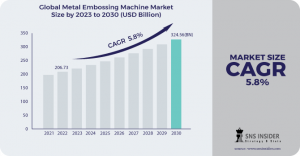Metal Embossing Machine Market to grow at CAGR of 3.5% | Driven by Growth in the Automotive and Construction Industries
Shaping the Future: Exploring the Metal Embossing Machine Market
TEXES, AUSTIN, UNITED STATES, June 12, 2024 /EINPresswire.com/ -- The Metal Embossing Machine Market Size is expected to see steady growth over the next decade. From a value of USD 57335 million in 2023, the market is anticipated to reach USD 75500 million by 2031.Download Sample Copy of Report: https://www.snsinsider.com/sample-request/2629
Top Key Players:
Caparo
Nissan Motor Company, Ltd
Kenmode, Inc.
Acro Metal Stamping Co
Manor Tool & Manufacturing
D&H Industries, Inc.
Klesk Metal Stamping Co.
Clow Stamping Company
Goshen Stamping Company
Tempco Manufacturing Company, Inc.,
INTERPLEX HOLDINGS PTE. LTD.
AAPICO Hitech Public Company Limited
Klesk Metal Stamping Co
A major driver is the rising demand for three-dimensional patterns on metal, particularly in the automotive sector accounting for over 70% of the market share.
This technique allows for intricate designs on car parts, enhancing brand identity and providing to consumer preferences for vehicle aesthetics. Moreover, metal embossing offers a cost-effective alternative to traditional printing methods, eliminating additional processes like cleaning or plating. This translates to significant savings, with estimates suggesting a reduction in overall costs by up to 20%.
While automation offers a solution, 70% of machines sold are still manual, favoured for their flexibility in low-volume, custom orders.
This creates a challenge for manufacturers seeking to bridge the gap. Additionally, with growing emphasis on sustainability, the industry grapples with 20% material waste generated during metal embossing. While some companies are implementing metal recycling programs, a significant portion hasn't yet adopted these practices.
Key Opportunity Avenues:
A growing emphasis on lightweight, high-strength materials like aluminium and magnesium in the automotive industry accounting for over 20% of the global metal embossing machine market creates a demand for machines capable of intricate designs without compromising structural integrity.
This opens doors for the use of embossed metal components in electric vehicles and battery enclosures. Additionally, the rising demand for customized and personalized consumer electronics makes the way for embossing techniques to create unique aesthetics on phone casings, laptop lids, and other consumer durables.
Political Trends:
Trade tensions, for instance, are pushing for a more localized production of embossed metal components. This translates to a potential rise in demand for machines by regional manufacturers, particularly in North America holding 38% of current market share and Europe 32% as they look to reduce dependence on imported parts.
Additionally, government regulations on product labelling and authentication are expected to fuel the high-volume embossing machine segment by 42%. Stringent quality control measures, especially in the automotive industry, will likely incentivize investments in automated embossing machines for precision and efficiency.
Asia Pacific, driven by a 78% expansion in manufacturing activities, particularly in China and India, is expected to be a dominant force.
This growth is driven by the construction boom in the region, with a 42% increase in demand for metal embossing machines for intricate architectural designs. Similarly, the Middle East and Africa are experiencing a 35% rise in the market, supported by rapid urbanization and extensive construction & infrastructure projects. Here, metal embossing machines find application in creating signage, decorative elements, and architectural features, providing to the region's evolving aesthetic preferences.
Buy Complete Report: https://www.snsinsider.com/checkout/2629
Recent Developments:
Companies like Ansys, though not a direct machine manufacturer, are contributing by launching software that simulates the metal forming process with up to 90% accuracy. This allows for better design optimization and reduces production errors.
Additionally, manufacturers are focusing on cost-reduction strategies. A 20% decrease in material waste was reported by Pannier Corporation through advancements in material handling within their machines.
Key Takeaways:
While both manual and automatic machines hold value, the market expects manual machines to remain dominant around 50% due to their affordability and suitability for low-volume, intricate metalwork in industries like automotive (3D patterns) and aerospace.
However, the focus on efficiency is promoting R&D efforts to bring down the cost of automation predicted growth of 3.2% to 3.6% across regions.
This will likely benefit high-volume applications in construction and packaging across regions like Asia-Pacific and the Middle East & Africa.
Akash Anand
SNS Insider | Strategy and Stats
+1 415-230-0044
email us here
Visit us on social media:
Facebook
X
LinkedIn
Instagram
YouTube
Legal Disclaimer:
EIN Presswire provides this news content "as is" without warranty of any kind. We do not accept any responsibility or liability for the accuracy, content, images, videos, licenses, completeness, legality, or reliability of the information contained in this article. If you have any complaints or copyright issues related to this article, kindly contact the author above.

